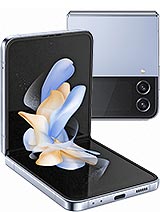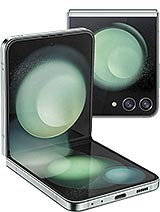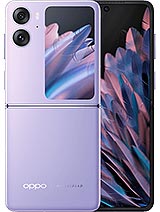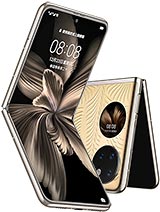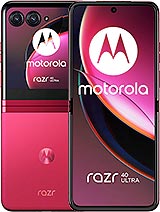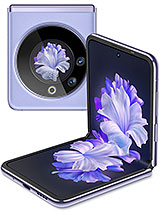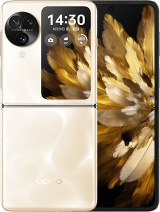Oppo Find N3 Flip review

Displays
The Oppo Find N3 Flip has two displays - a 6.8-inch foldable LTPO OLED with a thin protective film on top of it and a 3.26-inch AMOLED serving as a cover screen with Gorilla Glass Victus protection.
Let's start with the small screen. It's a 3.26-inch AMOLED with 720 x 382 pixels (250ppi) and a neat 17:9 aspect ratio, which should be ideal for portrait and video selfies. The screen has a typical brightness of 500nits and a peak brightness of 900nits. It cannot run all Android apps, but Oppo offers a rich selection of supported mini-apps, as well as a number of proprietary features and widgets for this little fella. We will explore those on the next page.

Then we have the real showstopper - the 6.8-inch foldable LTPO AMOLED of 2,520 x 1,080 pixels (403ppi), which makes for the usual 21:9 aspect ratio. This screen supports a dynamic 120Hz refresh rate, 240Hz touch sampling, and 1440Hz PWM dimming. The screen is HDR10+ certified, and the official brightness specs are 500nits for typical, 1,200nit for maximum auto, and 1,600 nits of peak brightness.

We can confirm the small display does reach the promised 500 nits of maximum manual brightness and does become quite bright under direct sunlight, enough to see what's on it.
We've completed the display measurements on the main screen, too. The maximum brightness in manual mode was 495nits in Vivid color mode and 520nits in Natural color mode. The maximum auto brightness also varies depending on the color mode - 939nits for Vivid and 989nits for Natural. That is not exactly 1,200 nits, but it is not that far, either.
The minimum brightness was just 1.9 nit.
Color accuracy
The Find N3 Flip supports sRGB and DCI-P3 color spaces and switches between those on app/content bass. Its display options offer three color modes - Natural, Pro and Vivid.
Vivid is the default one with soft and mostly accurate colors, except for the slightly bluish whites and grays. The Natural, on the other hand, has superb accuracy with a D65 white point. Finally, the most accurate mode is Pro Cinematic, with an outstanding accuracy to DCI-P3 color space.
You can tune the color temperature via a dedicated slider in each mode.
Refresh rate
The Oppo Find N3 Flip has three Refresh Rate modes - Auto, High, and Standard.

According to the official description, Auto switches automatically between different modes and can do from 1Hz up to 120Hz, but it also aims to improve balanced battery life. The High always aims for the maximum 120Hz refresh rate, when possible, while the Standard one does the same but only goes up to 60Hz for longer battery life.
Unfortunately, we couldn't test this as the integrated Android refresh rate indicator only showed 120Hz or 60Hz.
What we can confirm is that the refresh rate drops down to 60Hz for video playback and gaming.
Streaming and HDR
The foldable display on the Find N3 Flip supports HDR10 and HDR10 formats. The screen is recognized by all popular streaming apps as HDR10-capable. And thanks to the Widevine L1 support, they all stream high-resolution content hassle-free.
Visual enhancements
The Display options menu offers three visual enhancements - Image Sharpener, Video Color Boost and Bright HDR Video Mode.
Image Sharpener enhances the clarity of low-quality photos and videos. It uses more battery, naturally, and we are not sure when it really activates, probably across compatible installed apps, but we didn't have any.
Video Color Boost tries to widen the color gamut in SDR content and increases battery consumption. It is available in a limited selection of apps, and, once again, we had no such apps.
Battery life
The Oppo Find N3 Flip is powered by a 4,300 mAh battery. It has an LTPO OLED screen and runs on the latest flagship 4nm Dimensity 9200 chipset.
In our Active Use Test, the Find N3 Flip posted much better scores on the on-screen tests than the Z Flip 5, but it’s on par when it comes to voice calls. We do appreciate its 8 hours of gaming, for sure.
Expand to reveal our legacy battery test (Endurance rating). How we test now.
We have completed our battery life test, and the results are great. The N3 Flip offered over 15 and a half hours of web time and nearly 17 and a half hours of video playback.
The call time is also plenty enough at over 27 hours.
So, with an average standby of 210 hours, the Find N3 Flip scored a total endurance rating of 92 hours, which is better than most foldables in this form factor and mostly in line with the Find N2 Flip.

Our battery tests were automated thanks to SmartViser, using its viSerDevice app. The endurance rating denotes how long the battery charge will last you if you use the device for an hour of telephony, web browsing, and video playback daily. More details can be found here.
The Find N2 Flip gauged a slightly better total endurance rating because it clocked more video runtimes and 24 more standby hours.
Video test carried out in 60Hz refresh rate mode. Web browsing test done at the display's highest refresh rate whenever possible. Refer to the respective reviews for specifics. To adjust the endurance rating formula to match your own usage patterns check out our all-time battery test results chart where you can also find all phones we've tested.
Charging speed
The Oppo Find N3 Flip supports up to 44W fast wired charging even if it ships with a 67W Super VOOC charger. Its battery is split in two halves inside the phone.

According to the official press materials, the Find N3 Flip should go from 0% to 58% in 30 minutes with the supplied charger.
Well, in our testing, the charger recharged 36% of the N3 Flip's battery in 15 minutes, while another 15 minutes got us to 65% - even more than what Oppo has promised.
A full charge took exactly 51 minutes, which is the fastest among the competition.
The Find N3 Flip, much like the Find N2 Flip, doesn't support wireless charging - that seems to have died with the original Find N in the Oppo foldable lineup.
The battery options include features like Power Saving mode, Improved Standby (puts some apps to sleep automatically), and Optimized Charging.
Optimized Charging allows the Open to adapt its charging curves to your charging patterns (mostly related to overnight charging and your sleep routine), so it minimizes the time the battery spends at 100%. It will charge quickly up to 80% and will then only finish things off just before it thinks you're going to need the phone.
The Optimized Charging can be off, all day on, or enabled just for overnight charging.
Speakers
The Find N3 Flip borrows its hybrid stereo setup from the N2 Flip. There is a dedicated speaker at the bottom of the Flip and another one is at the top with two sound outlets - one top- and one front-facing.

In Oppo's implementation, either speaker will also output the other speaker's channel, at a much lower volume. Otherwise, they will observe the phone's orientation in space to assign the correct channel to the correct speaker, with the earpiece taking on the left channel when in portrait orientation.
The Oppo Find N3 Flip scored a Very Good mark on our loudness test. It sounds better than most of the compact foldables with some bass, good vocals, and well-presented high frequencies.
Use the Playback controls to listen to the phone sample recordings (best use headphones). We measure the average loudness of the speakers in LUFS. A lower absolute value means a louder sound. A look at the frequency response chart will tell you how far off the ideal "0db" flat line is the reproduction of the bass, treble, and mid frequencies. You can add more phones to compare how they differ. The scores and ratings are not comparable with our older loudspeaker test. Learn more about how we test here.
Reader comments
- santosh
- 06 Feb 2025
- XpV
OPPO Find N3’s “Premium Service” is a Complete Disaster – No Support for 2 Weeks! I am beyond frustrated and disappointed with OPPO’s so-called “premium service support” for the OPPO Find N3. The service has been nothing short of a nightmare—zero a...
- YUKI93
- 21 Dec 2024
- K1F
I definitely hope the next Find N5 Flip ditches the circular camera island and goes back to a vertical camera layout like in the Find N2 Flip. I think Oppo are on to something with the outer screen design, especially when it has a near 16:9 aspect ra...
- Anonymous
- 02 Jan 2024
- PII
Can
